
The trogons and quetzals are birds in the order Trogoniformes which contains only one family, the Trogonidae. The family Trogonidae contains 46 species in seven genera. The fossil record of the trogons dates back 49 million years to the Early Eocene. They might constitute a member of the basal radiation of the order Coraciiformes and order Passeriformes or be closely related to mousebirds and owls. The word trogon is Greek for "nibbling" and refers to the fact that these birds gnaw holes in trees to make their nests.
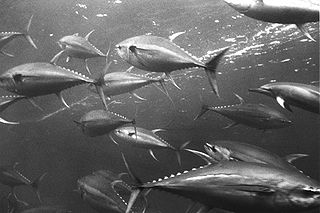
The mackerel, tuna, and bonito family, Scombridae, includes many of the most important and familiar food fishes. The family consists of 51 species in 15 genera and two subfamilies. All species are in the subfamily Scombrinae, except the butterfly kingfish, which is the sole member of subfamily Gasterochismatinae.

The Coraciiformes are a group of usually colourful birds including the kingfishers, the bee-eaters, the rollers, the motmots, and the todies. They generally have syndactyly, with three forward-pointing toes, though in many kingfishers one of these is missing. The members of this order are linked by their "slamming" behaviour, thrashing their prey onto surfaces to disarm or incapacitate them.

The mousebirds are birds in the order Coliiformes. They are the sister group to the clade Cavitaves, which includes the Leptosomiformes, Trogoniformes (trogons), Bucerotiformes, Piciformes and Coraciformes. This group is now confined to sub-Saharan Africa, and it is the only bird order confined entirely to that continent, with the possible exception of turacos which are considered by some as the distinct order Musophagiformes, and the cuckoo roller, which is the only member of the order Leptosomiformes, and which is found in Madagascar but not mainland Africa. Mousebirds had a wider range in the Paleogene, with a widespread distribution in Europe and North America during the Paleocene.

The Guianan trogon, is a near passerine bird in the trogon and quetzal family Trogonidae. It is found in Brazil, French Guiana, Guyana, Suriname, Trinidad, and Venezuela.

The Amazonian black-throated trogon is a bird in the family Trogonidae, the trogons and quetzals. Although it has also been called "yellow-bellied trogon" it is not the only trogon with a yellow belly. It is found in every mainland South American country except Argentina, Chile, Paraguay, and Uruguay.
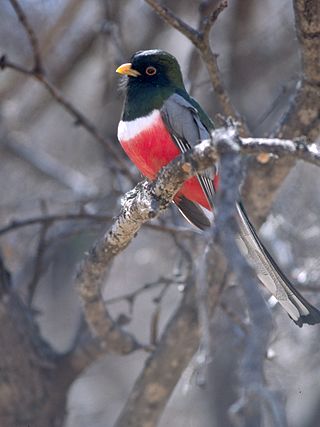
Trogon is a genus of Coraciimorphae birds in the trogon family. Its members occur in forests and woodlands of the Americas, ranging from southeastern Arizona to northern Argentina.

The eared quetzal, also known as the eared trogon, is a near passerine bird in the trogon family, Trogonidae. It is native to streamside pine-oak forests and canyons in the Sierra Madre Occidental of Mexico from northern Sonora and Chihuahua south to western Michoacán. The species has occurred on rare occasions in southeastern Arizona, where it has been recorded nesting.

Apalharpactes is a genus of birds in the family Trogonidae. They are restricted to humid highland forest on the Indonesian islands of Java and Sumatra. Unlike all other Asian trogons, their plumage is mainly green above and yellow below. Compared to most trogons, the sexual dimorphism is relatively small. The two species in the genus resemble each other, but A. reinwardtii is larger than A. mackloti, and the male A. mackloti has a chestnut rump-patch, which A. reinwardtii lacks. They feed on arthropods, small lizards and fruit.

The Javan trogon is a species of bird in the family Trogonidae. The species was once lumped together with the Sumatran trogon in a single species, the blue-tailed trogon, but differences in size, weight, and plumage have led to the two being split. These two species were once lumped with the rest of the Asian trogons in the genus Harpactes, but have been split into their genus due to differences in plumage.
The bare-cheeked trogon is a species of bird in the family Trogonidae found in the rainforests of western central Africa.

The red-headed trogon is a species of bird in the family Trogonidae.

The orange-bellied trogon is a subspecies of the collared trogon in the family Trogonidae. It is now usually considered as a morph of the collared trogon, but was previously sometimes treated as a separate species. It is found in the Talamancan montane forests of Costa Rica and Panama.
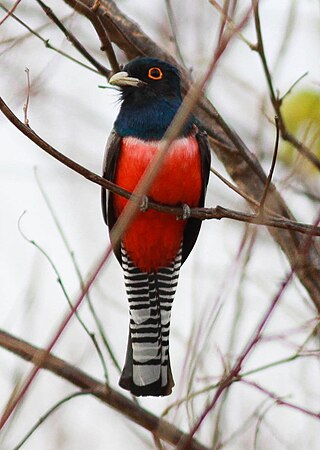
The blue-crowned trogon is a species of bird in the family Trogonidae, the quetzals and trogons. It is found in Brazil, Argentina, Bolivia, Colombia, Ecuador, Paraguay, and Peru. As with all trogons, this species is sexually dimorphic. The male has a blue head with an orange orbital ring, a red belly with a narrow white breastband and a green back. The female differs in having a grey head, a grey back and a broken white eye-ring.

The mountain trogon, also known as the Mexican trogon, is a species of bird in the family Trogonidae. First described by William John Swainson in 1827, it is resident in Guatemala, Honduras, and Mexico and has occurred in El Salvador as a vagrant. Like all trogons, the mountain trogon is sexually dimorphic. The male is metallic green on the crown, nape, upperparts and chest, the latter separated from its bright red belly and vent by a narrow band of white. The female is warm brown on the head, upperparts and chest, separated from its paler brown lower chest and red belly and vent by a narrow white band.
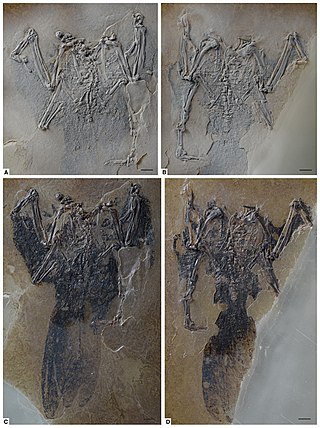
Archaeotrogonidae is a prehistoric bird family known from the Eocene and Oligocene of Europe. They are members of Strisores, and are thought to be closely related to nightjars.

The Fur Formation is a marine geological formation of Ypresian age which crops out in the Limfjord region of northern Denmark from Silstrup via Mors and Fur to Ertebølle, and can be seen in many cliffs and quarries in the area. The Diatomite Cliffs is on the Danish list of tentative candidates for World Heritage and may become a World Heritage site. Fossils found in the Fur Formation are primarily housed at the Fossil and Mo-clay Museum on Mors Island, the Fur Museum on Fur Island, and the Natural History Museum of Denmark in Copenhagen.
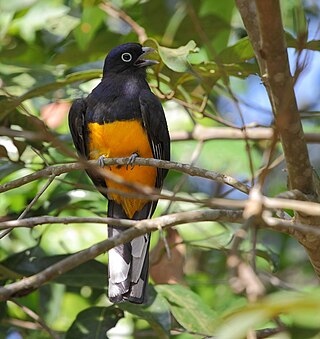
The green-backed trogon, also known as the Amazonian white-tailed trogon, is a bird in the trogon family Trogonidae. It is widely distributed across the Amazon rainforest with a disjunct population on the southeast coast of Brazil. As with all trogons, this species is sexually dimorphic. The male has a yellow belly without a white breastband, a blue head with a pale-blue orbital eye-ring, a blue bill, a green back and a green tail that is mostly white below. The female is duller with a dark grey head, a dark grey back and some black barring beneath the tail.

Masillatrogon is an extinct genus of trogon. Its remains were found in the Messel Pit of Germany.
Gerald Mayr is a German palaeontologist who is Curator of Ornithology at the Senckenberg Research Institute in Frankfurt am Main, Hesse. He has published extensively on fossil birds, especially the Paleogene avifauna of Europe. He is an expert on the Eocene fauna of the Messel pit.















